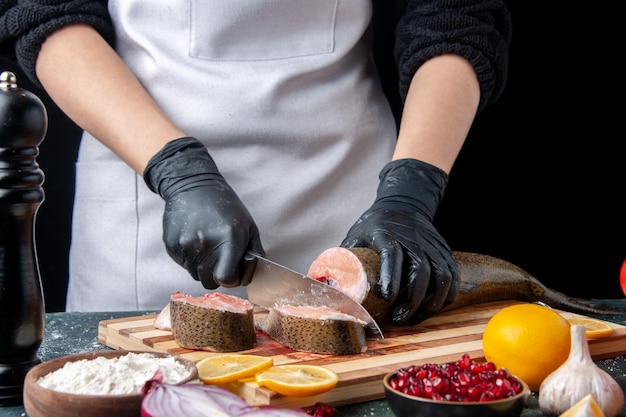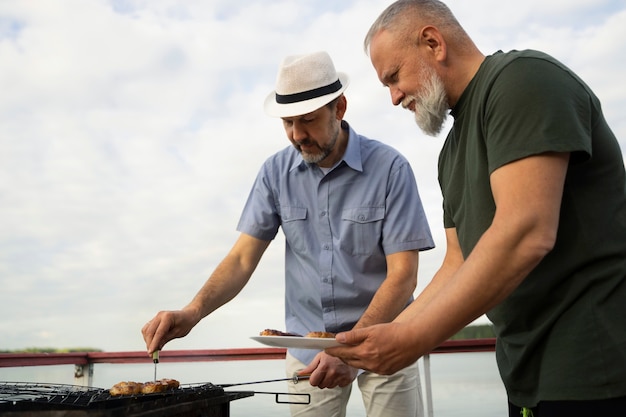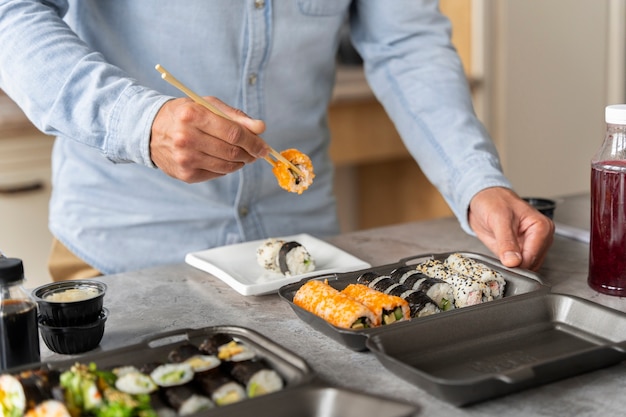As a seasoned home cook and self-proclaimed fish enthusiast, I’ve spent countless hours perfecting my salmon grilling technique. It’s a dish that’s become a staple in my culinary repertoire, and I’m always thrilled to share my tips and tricks with anyone who’s willing to listen (and eat!).
There’s nothing quite like the flavour of perfectly grilled salmon. It’s a dish that’s both elegant and satisfying, perfect for a special occasion or a casual weeknight meal. But achieving that "just right" level of doneness can be a bit tricky, especially if you’re new to grilling. A little too long on the heat, and you end up with dry, flaky salmon. A tad too short, and it’s raw in the middle.
But fear not! With a few key pointers and a bit of practice, you too can master the art of grilling salmon to juicy perfection. Let me guide you through my tried-and-true methods, from choosing the right fish to knowing exactly when it’s ready to come off the grill.
(Part 1) Selecting the perfect salmon

The journey to delicious grilled salmon starts with the right fish. Now, I’m not saying you need to be a fishmonger to pick out a great piece of salmon, but there are a few things to keep in mind when you’re making your selection.
Freshness First
You want to make sure the salmon you're buying is fresh. Look for bright, glistening skin and flesh that's firm to the touch. Avoid salmon that's dull or slimy. The gills should be red and not brown or discoloured. One of my favourite ways to gauge freshness is by pressing my finger gently on the flesh – it should spring back with a slight bounce. It’s also a good idea to check the “best by” date on the packaging. And, if you’re at a fishmonger, don’t be afraid to ask about their sourcing practices and how long the fish has been in stock.
Skin-On, Bone-In
If you're grilling, I recommend going for skin-on, bone-in salmon fillets. The skin helps prevent the salmon from sticking to the grill, and the bones add flavour to the flesh. You can always remove the skin and bones after grilling if you prefer. But personally, I find the skin crispy and the bones add a lovely richness to the final dish. It’s a little extra effort, but worth it!
Size Matters
When it comes to size, it depends on how many people you’re feeding. You want a fillet that’s thick enough to withstand grilling without falling apart. A fillet that’s about 1-1.5 inches thick is ideal, but I’ve also had success grilling thinner fillets, as long as I watch them carefully. If you’re grilling smaller fillets, consider grilling them over medium-low heat to avoid overcooking.
Getting Creative
Don’t be afraid to experiment! wild salmon is a classic choice, but farmed salmon is also a great option, and it tends to be more readily available. Look for different varieties like sockeye, king, or coho salmon. Each has its unique flavour and texture, and you might just find a new favourite. sockeye salmon, for instance, has a rich, deep flavour and a firm texture, while coho salmon is known for its milder flavour and slightly oily texture.
(Part 2) Prepping the Salmon for the Grill

Okay, so you’ve got your salmon, and you’re ready to get grilling. But before you throw it on the heat, there’s a little prep work to do.
Pat It Dry
First things first, pat the salmon dry with paper towels. This is crucial, as it prevents the salmon from steaming on the grill and helps achieve a nice crispy skin.
Seasoning Time
Now for the fun part – seasoning! I’m a firm believer that less is more when it comes to seasoning salmon. A simple sprinkle of salt and pepper is all you really need, but feel free to get creative.
Here are some of my go-to seasoning combos:
- Salt, pepper, and a squeeze of lemon juice – this is a classic combination that brightens up the flavour of the salmon.
- Salt, pepper, and a drizzle of olive oil – a simple yet effective way to add moisture and flavour.
- Salt, pepper, paprika, and garlic powder – this combo adds a warm, smoky flavour to the salmon.
- Salt, pepper, and a herb blend (like thyme, rosemary, or dill) – herbs like thyme and rosemary complement the flavour of salmon beautifully.
You can also experiment with other spices, like cayenne pepper, cumin, or coriander. Just be sure not to overdo it! Too many spices can overpower the delicate flavour of the salmon.
The Importance of Oil
A light coating of olive oil or another neutral oil will help prevent the salmon from sticking to the grill. Simply brush the fillets with a thin layer of oil. This will create a barrier between the salmon and the grill grates, helping to prevent sticking. You can also use a spray oil if you prefer.
Getting Ready for the Grill
If you’re using a gas grill, preheat it to medium heat (about 350-400 degrees Fahrenheit). If you’re using a charcoal grill, let the coals heat up until they’re covered in white ash. You’ll know your grill is ready when you hold your hand a few inches above the grate and you can feel the heat.
(Part 3) Grilling Salmon to Perfection

Now comes the fun part! It’s time to get your salmon on the grill.
Direct or Indirect
When grilling salmon, you have two main options: direct grilling or indirect grilling.
Direct grilling involves placing the salmon directly over the heat source, which cooks the salmon more quickly and results in a crispier skin. This is a great option for smaller fillets. For direct grilling, make sure the heat is evenly distributed across the grill, and that the grates are clean and lightly oiled. You may need to rotate the salmon during grilling to ensure even cooking.
Indirect grilling, on the other hand, involves cooking the salmon over indirect heat, which cooks the salmon more gently and evenly. This is a better choice for larger fillets or if you want to avoid overcooking. To achieve indirect grilling, you can move the coals to one side of the grill, or you can turn off the burners on one side of a gas grill. Place the salmon over the indirect heat, and the heat from the direct side will gently cook the fish.
grilling tips
Here are some extra tips for grilling salmon to perfection:
- Don't overcrowd the grill. If you're grilling multiple fillets, give them space to cook evenly. Cramming too many fillets on the grill can cause them to steam rather than grill, resulting in a less desirable texture.
- Use a grill basket to prevent the salmon from sticking and falling through the grates. A grill basket can be especially helpful if you're grilling smaller fillets or if you’re using a gas grill with thinner grates.
- Don't flip the salmon too often. Only flip it once, when the skin is nicely browned and the flesh is cooked halfway through. Flipping the salmon too often can disrupt the cooking process and make it more difficult to achieve a crispy skin.
- Use a meat thermometer to check for doneness. Salmon is cooked through when the internal temperature reaches 145 degrees Fahrenheit. A meat thermometer is a simple yet essential tool for ensuring that your salmon is cooked to perfection.
(Part 4) Knowing When Salmon is Done
It’s a bit of an art to know when salmon is cooked to perfection. But there are a few signs to look for:
The Color Test
The flesh of cooked salmon will turn opaque and flake easily with a fork. It will no longer be translucent or raw-looking.
The Skin Test
The skin should be crispy and slightly browned.
The Touch Test
Gently press the flesh of the salmon with a finger. It should be firm and spring back.
The Thermometer Test
For the most accurate way to determine doneness, use a meat thermometer. Insert it into the thickest part of the salmon, making sure it doesn’t touch a bone. The internal temperature should reach 145 degrees Fahrenheit.
overcooked salmon
If the salmon is overcooked, it will be dry and flaky. To avoid this, cook it for a shorter amount of time or use the indirect grilling method. If you’re using a gas grill, you can reduce the heat to medium-low or move the salmon to a cooler part of the grill.
(Part 5) Resting the Salmon
Once the salmon is cooked to your liking, it’s important to let it rest for a few minutes before serving. This allows the juices to redistribute, resulting in a more tender and flavourful fish.
Transfer the salmon to a cutting board and cover it loosely with foil. Let it rest for about 5-10 minutes, depending on the thickness of the fillets.
(Part 6) Serving Salmon
After resting, your salmon is ready to serve. There are endless possibilities for how to enjoy this delicious dish. Here are a few ideas:
Simple and Delicious
- Serve the salmon with a side of roasted vegetables, like asparagus, broccoli, or Brussels sprouts. The sweetness of roasted vegetables complements the rich flavour of salmon perfectly.
- Pair it with a light salad with a vinaigrette dressing. A simple salad with a tangy vinaigrette can cut through the richness of the salmon and provide a refreshing contrast.
- Top it with a dollop of lemon butter sauce. The tangy lemon and rich butter sauce add a touch of elegance to the salmon.
- Serve it with a side of couscous or quinoa. These grains are light and fluffy, making a perfect complement to the salmon.
Get Creative
- Make a salmon salad sandwich on a toasted bun. This is a great way to use leftover salmon for a quick and easy lunch.
- Flake the salmon and add it to a pasta salad. Flaked salmon adds a protein boost and a delicious flavour to pasta salad.
- Wrap the salmon in a tortilla with your favourite toppings for a healthy burrito. A salmon burrito is a great way to enjoy a satisfying and healthy meal.
- Add the salmon to a stir-fry. Flaked salmon can be added to a stir-fry for a quick and easy meal.
(Part 7) cooking times
Knowing how long to grill salmon depends on the thickness of the fillet, the heat of your grill, and your preferred level of doneness.
Here’s a general guideline for grilling salmon:
| Thickness (inches) | Grilling Time (minutes) |
|---|---|
| 0.5-1 | 4-6 |
| 1-1.5 | 6-8 |
| 1.5-2 | 8-10 |
Keep in mind that these are just estimates. You may need to adjust the grilling time based on your specific grill and desired doneness. For instance, if your grill is running a little hot, you may need to reduce the grilling time.
(Part 8) Tips for Making Salmon Even Better
There’s always more to learn in the kitchen, and when it comes to salmon, here are a few extra tips to up your game:
Marinate it
For extra flavour, consider marinating the salmon for 30 minutes to a few hours before grilling. You can use a simple marinade made with olive oil, lemon juice, and herbs, or get creative with other ingredients like soy sauce, honey, or chili flakes.
Here’s a simple marinade recipe you can try:
Ingredients:
- 1/4 cup olive oil
- 2 tablespoons lemon juice
- 1 tablespoon chopped fresh herbs (such as thyme, rosemary, or dill)
- 1/2 teaspoon salt
- 1/4 teaspoon black pepper
Instructions:
- Combine all ingredients in a small bowl and whisk to combine.
- Pour the marinade over the salmon fillets and refrigerate for 30 minutes to a few hours.
- Before grilling, pat the salmon dry with paper towels.
Glaze It
A glaze can add a beautiful shine and extra flavour to your grilled salmon. Brush a glaze of honey, soy sauce, and ginger over the salmon during the last few minutes of grilling. The glaze will caramelize on the grill, creating a delicious and visually appealing finish.
Here’s a simple glaze recipe you can try:
Ingredients:
- 1/4 cup honey
- 2 tablespoons soy sauce
- 1 tablespoon grated fresh ginger
Instructions:
- Combine all ingredients in a small bowl and whisk to combine.
- Brush the glaze over the salmon fillets during the last 5 minutes of grilling.
- Continue grilling until the glaze is caramelized and the salmon is cooked through.
Don’t Be Afraid to Experiment
The world of salmon is your oyster (or should I say, your salmon!). Try different cooking methods, seasonings, and toppings. You’ll be surprised at how many delicious ways there are to prepare this versatile fish. You can try grilling salmon with fruit like mango or pineapple, or add a touch of spice with chili flakes or harissa paste. The possibilities are endless!
(Part 9) FAQs
Let’s tackle a few common questions that pop up when people are grilling salmon.
1. What's the best way to tell if salmon is done?
The best way to tell if salmon is done is by using a meat thermometer. It should reach an internal temperature of 145 degrees Fahrenheit. You can also look for other signs of doneness, like opaque flesh that flakes easily and crispy skin.
2. Can I grill salmon skin-side down?
Yes, you can grill salmon skin-side down, but it's not necessary. The skin will help prevent the salmon from sticking to the grill, but it can be removed after grilling if you prefer. If you grill skin-side down, make sure the heat is medium-low to prevent burning the skin.
3. How do I prevent salmon from sticking to the grill?
To prevent salmon from sticking to the grill, make sure the grill grates are clean and lightly oiled. You can also use a grill basket or parchment paper to help keep the salmon from sticking. Parchment paper is a great option for smaller fillets, as it will prevent them from sticking and will also make cleanup a breeze.
4. What if my salmon is overcooked?
If your salmon is overcooked, it will be dry and flaky. You can still enjoy it, but it won't be as moist and tender as it could be. To avoid overcooking, use a meat thermometer to check the internal temperature and cook it for a shorter amount of time. If you’re grilling over direct heat, consider moving the salmon to a cooler part of the grill.
5. What can I do with leftover grilled salmon?
Leftover grilled salmon is great in salads, sandwiches, and pasta dishes. It can also be flaked and added to soups and stews. You can even make salmon patties or fish cakes.
Grilling salmon is a skill that takes practice, but with these tips and a little patience, you'll be on your way to grilling salmon perfection. Happy grilling!
Everyone is watching

How to Cook Frozen Lobster Tails Perfectly: A Step-by-Step Guide
RecipesLobster. Just the word conjures up images of lavish meals, special occasions, and a taste of luxury. But let's...

Pork Fillet Cooking Time: How Long to Cook It Perfectly
RecipesPork fillet, or tenderloin as it's sometimes called, is a real favourite in our house. It's so versatile, and...

Pigs in a Blanket Cooking Time: How Long to Bake for Perfect Results
RecipesAh, pigs in a blanket. Just the name conjures up images of those delightful little parcels of crispy pastry en...

The Ultimate Guide to Cooking Delicious Frankfurters
RecipesLet's face it, we all love a good frankfurter. It's a classic, simple, and always satisfying. But let's be rea...

Wolf Meat Recipes: A Guide to Cooking Wild Game
RecipesLet's be honest, you don't see wolf meat at your local butcher shop every day. It's a bit of a wild card, but ...
